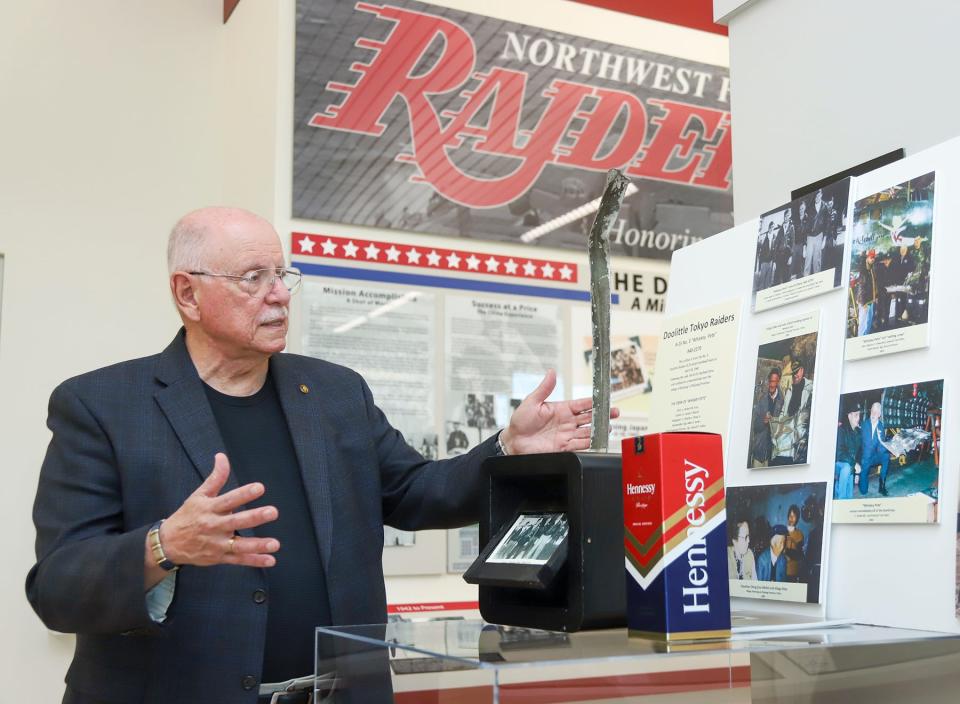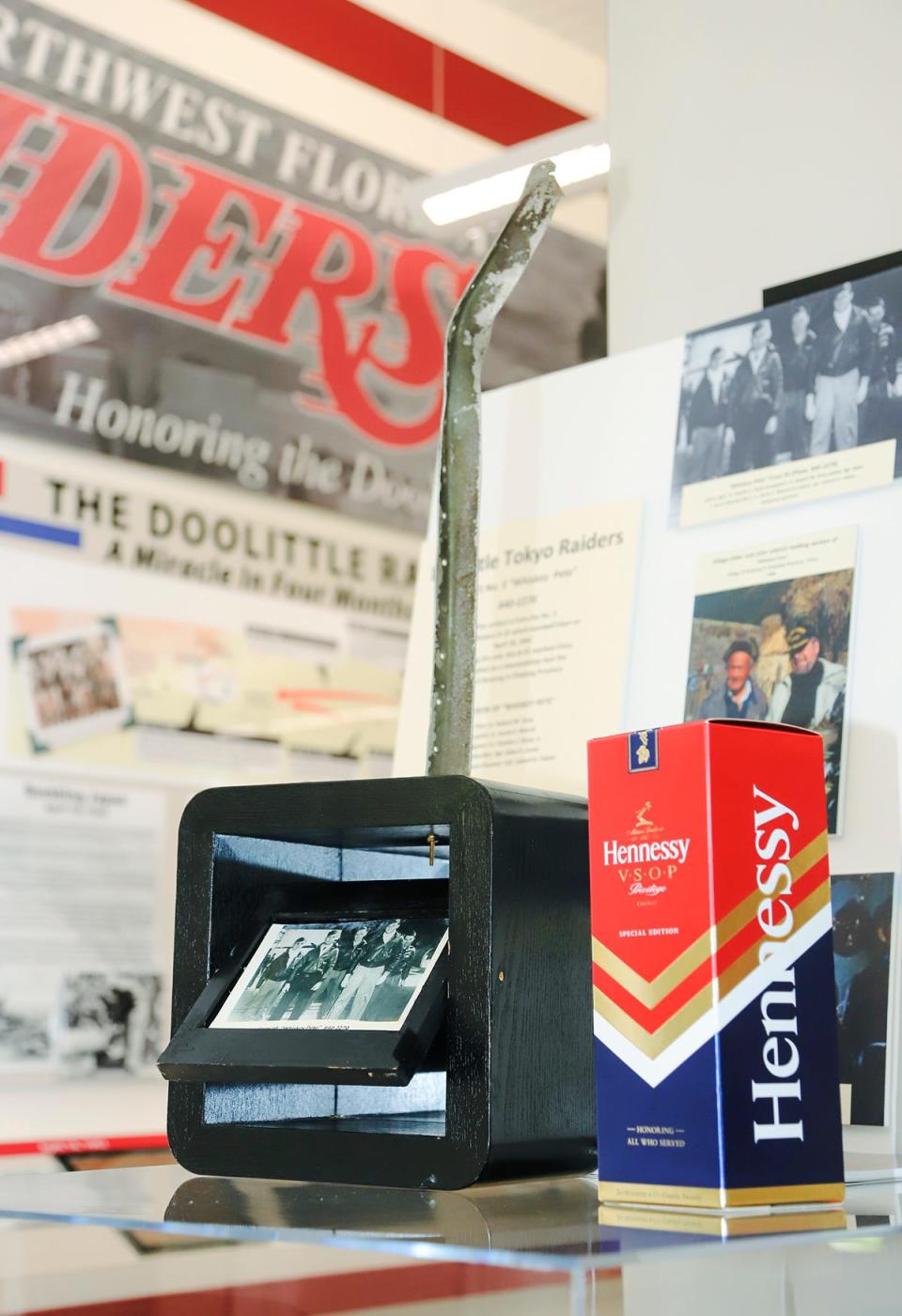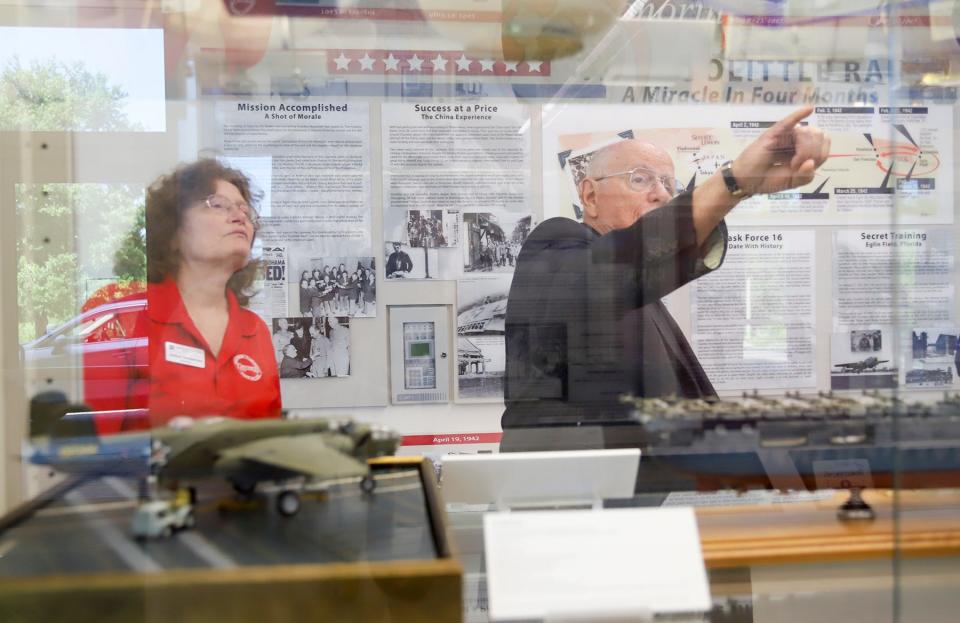'The true home': Northwest Florida State College gets piece of historic Doolittle Raider bomber
NICEVILLE — The display at Northwest Florida State College's Raider Arena honoring the Doolittle Raiders — the 80 Army Air Forces airmen who volunteered for a daring and successful World War II bombing mission over Japan — now has an artifact of that mission that would be the envy of any museum.
At a dinner following the recent "Final Goblet" ceremony at the college — a toast marking the 2019 passing of the final member of the Doolittle Raiders, retired Air Force Col. Dick Cole — the college was presented with a piece of one of the modified B-25 Mitchell bombers that participated in the raid.
"From a curator perspective, it's 'Oh, my gosh!' " said retired Air Force Col. Frank Goldstein, who watches over the exhibit and is always on the lookout for additional artifacts to display.

One last toast: Legacy of Doolittle Raiders honored at 'extraordinary' Final Goblet event
"I think I'm the 'on the prowl' guy," Goldstein said.
The history of the Doolittle Raiders is deeply ingrained in the area — as reflected, among other places, in the college's Raider mascot — because the airmen trained at what was then Eglin Field for three weeks prior to the mission.
The artifact is identified as a metal rib from a panel that had been part of the rear fuselage of the B-25 Mitchell bomber dubbed "Whiskey Pete" in honor of a dog owned by its pilot, Lt. Robert M. Gray, when he was a boy. The narrow and twisted piece of metal is about a foot long, and the college is working now on a plan for the best way to display it.

"Whiskey Pete" was the third among the 16 B-25s that launched from the deck of the aircraft carrier USS Hornet — the first time bombers had taken off from a carrier — on April 18, 1942, in a successful effort to bomb industrial and military targets in Japan just four months after the sneak Japanese air attack on Pearl Harbor, Hawaii, that devastated the American navy. The raid did not cause significant damage, but it gave U.S. troops and the American public a morale boost and proved that Japan could be made vulnerable to air attacks.
Because the Hornet was spotted by a Japanese patrol boat prior to the scheduled launch of the bombers, they had to take off early. Without sufficient fuel to return the Hornet, most of the crews were forced to bail out over China. One aircraft ditched in the ocean, and another landed in Russia.
The artifact from "Whiskey Pete" was presented to NWF State by Chen Sao Chan, a native of China also known as Eva Uldrich, widow of the late John Uldrich, a retired Marine. Along with the metal rib, she included a note calling the college "the true home" of the piece.
John Uldrich, who in 1995 formed the B-25 Recovery Group in an as yet unsuccessful effort to retrieve a crashed B-25 from Pennsylvania's Monongahela River, separately traced the wreckage of what turned out to be "Whiskey Pete" to the village of Beiyang in China's Zhejiang Province.
The Uldriches, who lived in China for some time, "were always very interested in finding stuff," according to Robert Shema, another member of the B-25 Recovery Group.
The couple knew about the Doolittle Raiders, and in 1998 on what Shema described as "sort of a busman's holiday," they located a metal panel from "Whiskey Pete," which included the metal rib presented to the college, in the rafters of a village hall in Beiyang.
Last Doolittle Raider dies: Col. Richard Cole was regular visitor to Emerald Coast
The panel, given to the Uldriches by a village elder, had originally been removed from the aircraft in 1942. Goldstein said he plane, as with other wartime detritus everywhere, routinely was scavenged by local residents and turned into various household implements or used for home repairs, so it's unusual that any pieces would survive intact except for crash damage.
"They were cannibalized for domestic consumption," Goldstein said.
A few years after their 1998 find, the Uldriches brought the panel back to the United States, where John Uldrich and Minnesota Air National Guard personnel who worked with "Miss Mitchell" — another B-25 that belongs to the Minnesota Wing of the Commemorative Air Force, a Texas-based nonprofit organization that preserves and exhibits historical aircraft — vetted it to determine its origins.
Serial numbers, located at various places on the panel confirmed that it was from "Whiskey Pete."
Shema and Goldstein are convinced of its authenticity.

"There don't appear to be any gaps" in the story of the panel and the rib presented to the college, Goldstein said.
"I don't think there's any question about that," Shema agreed.
He said one reason for his certainty that the inscribing of serial numbers on military aircraft of the day "was much more extensive" than on civilian aircraft.
While the Raider Arena exhibit features uniforms, equipment and other items from the World War II era and the Army Air Forces, along with memorabilia from Doolittle Raider reunions, the metal rib is just one of two artifacts that actually were on the mission. The other is a set of metal drinking cups carried by Lt. William Fitzhugh aboard his aircraft and donated to the exhibit by his family.
Having an actual piece of one of the aircraft, however, moves the Doolittle Raider exhibit at Raider Arena into unfamiliar territory, with questions looming about how and where to best display the piece.
"This is brand new to us," said college librarian Janice Henderson, who is custodian of the Doolittle Raider material at the exhibit and in the college's library.
Henderson said she has reached out to the college's art gallery for some ideas on integrating the piece from "Whiskey Pete" into the exhibit and updating the overall exhibit. One possibility might be to pair the metal rib with a piece from the runway where the Doolittle Raiders trained, saved by a worker when the runway was replaced some years ago, she suggested.
That approach would unite the pieces and recall the moment in time when "this piece was on this runway," she said, gesturing toward the two artifacts.
"We have some unique issues," added Goldstein, who pointed out that because the exhibit is in an entry to the arena, foot traffic patterns can't be interrupted and exhibits can't extend too far out from the walls.
In addition to getting the piece of "Whiskey Pete," the college was also presented at the recent dinner with another bit of Doolittle Raiders memorabilia.
Hennessy, the liquor company that has provided the cognac for the Doolittle Raider reunions with which the airmen toasted fellow airmen who had died since the previous reunion, donated the special commemorative bottle used at the "Final Goblet" ceremony to the college.
Unlike with the metal rib, the college does have some idea for preserving the cognac bottle, which still contains some cognac. The Doolittle Raider exhibit already includes a bottle of Hennessy cognac from a previous reunion, also with some cognac remaining inside. Following that donation, Goldstein said, it was decided to seal the top of the bottle with epoxy, which appears to have stopped any evaporation of the alcohol.
This article originally appeared on Northwest Florida Daily News: Northwest Florida State College gets piece of Doolittle Raider bomber

